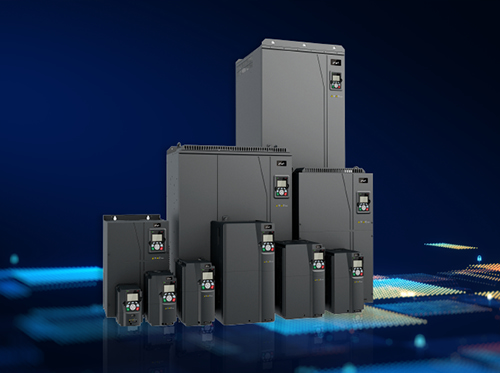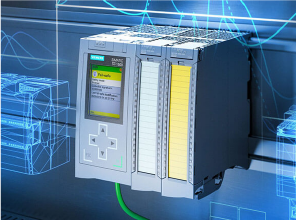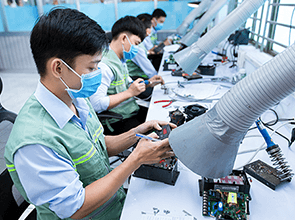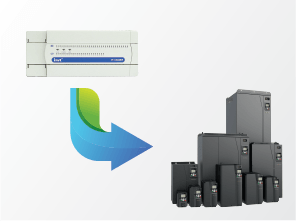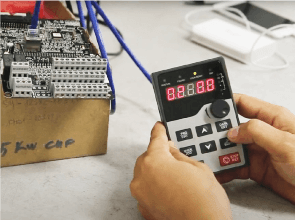What are the benefits of using a VFD in motor control?
A VFD, often thought of as an automation device, functions like a versatile tool for controlling motor speed smoothly and efficiently. It is considered the most advanced non-contact modern motor speed control device in the world, equipped with outstanding features that satisfy all users. A VFD, or semiconductor drive, is a means of connecting the entire world of transmission and is changing the way people think about electric drive control and energy management.
According to Dr. Le Tong, a leading expert in the field of electric drives in Vietnam, VFD technology has experienced rapid growth in Vietnam in recent years, promising a highly potential market.
1. Benefits of Using INVT VFDs
One of the most remarkable features of VFD motor drives is the ability to precisely control motor speed continuously. This means that by adjusting the frequency, you can control the motor’s speed within a wide range as per your requirements.
Using a VFD also implies that you automatically gain access to numerous intelligent and flexible features, such as automatic motor recognition, network control capability, the ability to set 16-speed levels, controlling motor starting current for a smoother and enhanced mechanical structural lifespan, reduced installation and maintenance costs, space-saving installation, energy-saving modes, and more. You will no longer worry about not having control over the energy during the transmission process, as VFDs allow you to control it through overcurrent, overheat, overcurrent, overvoltage, undervoltage, phase loss, phase deviation, and more protection modes.
Especially, VFDs with “Sensorless Vector SLV” or “Vector Control With Encoder Feedback” modes offer even more advanced features. They provide a wide speed adjustment range and high starting torque, up to 200% of rated power or more. The low-speed rotation fluctuation is minimized, improving the stability and precision of the working process. They offer high torque even at low-speed ranges, reaching 150% of rated torque at speed 0.
2. Application Range
Semiconductor VFDs are used to start and control the speed of three-phase squirrel-cage induction motors. There are various power sizes available, suitable for different motor power types. All VFD manufacturers develop two different product lines to suit various applications.
Some Considerations When Using VFDs:
- Choose a VFD that fits your application to minimize costs and ensure reliable operation.
- Ensure that the VFD is rated for tropical environments, as Vietnam’s climate is hot and humid.
- Make sure the installation conditions, including temperature, humidity, and location, meet the requirements.
- VFDs cannot be used outdoors and should be installed in cabinets with good ventilation (the cabinet must have a fan for ventilation). The installation location should be dry in a room with a temperature below 50°C, no corrosive substances, gas, dust, at an altitude below 1000m above sea level.
- Read the user manual carefully. If you don’t understand or are unsure, do not attempt to connect or change the set parameters yourself.
- Seek guidance from technical experts from the VFD manufacturer for installation and configuration to achieve optimal operation for your application.
- When the VFD reports an error, look up the error code in the documentation and investigate the causes of the error. Restart only when the issue has been resolved.
- Each VFD comes with a quick reference guide. You should record detailed information about the parameters you have changed and any observed errors in this guide, as it is essential for experts to troubleshoot any issues.
In conclusion, today’s VFDs are no longer a luxury for those with a high budget. The benefits they offer far outweigh the cost, so do not hesitate to invest in VFDs for your drive systems where VFD applications are possible. It is a sound investment, a comprehensive and long-term investment strategy.
Most VFD types available today provide open communication structures that are integrated with various fieldbus module options, giving designers and users many choices for integrating VFDs with other machinery and equipment.
Considering the basic functionality, AC VFDs do not seem much different from a decade ago. They control motor speed and torque, protect the motor, and allow users to adjust operating parameters such as acceleration and deceleration time. However, thanks to super-compact processors, today’s VFDs are smarter, more interactive, and an integral part of industrial automation systems. Most VFDs available today provide open communication structures that are integrated with various fieldbus module options, giving designers and users many choices for integrating VFDs with other machinery and equipment.
3. Networking and Remote Access
As remote diagnostics, monitoring, and remote networking become increasingly popular, communication solutions for VFDs have become more critical than ever. The new generation of smart VFDs provides advanced built-in communication solutions, making it easier for users to connect VFDs to production processes through open networks. This saves space compared to solutions that use separate communication cards attached to the VFD.
In addition to internal communication modules that can connect directly to standard industrial networks, today’s VFDs can be seamlessly integrated into the entire production process. Moreover, there are RS232 communication modules that support VFDs, providing direct communication to a PC. With such extensive support, users can install, diagnose, monitor, and analyze the entire process. When multiple VFDs are connected on the same network, users can monitor and configure all VFDs from a single point.
4. Smart Programming
Real-time embedded operating systems in today’s VFDs run on powerful processors with flash memory support for loading and saving user programs. They also come with comprehensive function block libraries, including PID, filters, counters, timers, latches, and high-level macro function blocks like expansion control.
Intelligent programming VFDs can automatically adjust the speed when voltage drops and restore it when the voltage returns to normal. With synchronous starting capability, VFDs can automatically determine the motor’s rotation speed during voltage sag and restore it to normal voltage.
5. Decentralized Control
The new generation of intelligent VFDs provides users with an efficient ‘PLC within the VFD’ solution without the need for a separate PLC or controller. The control module contains embedded intelligence that can be installed in the VFD, providing an economical platform for system designers to develop specialized application programs. This allows for real-time peer-to-peer control at high speeds.
Distributed control, combined with advanced, low-cost embedded CPU technology, creates a more flexible and cost-effective system that suits various applications. Many automation applications, such as web-based processing lines, material handling, and conveyor systems, are ideal environments for this type of control.


